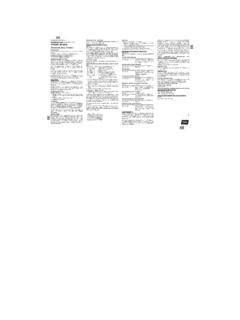Transcription of IBUMAX COLD AND FLU (Film-coated tablets)
1 S2S2 SCHEDULING STATUS:PROPRIETARY NAME (AND DOSAGE FORM): IBUMAX cold AND FLU ( film - coated tablets )COMPOSITION:Each film - coated tablet contains 200 mg ibuprofen and 30 mg pseudoephedrine hydrochloride. Inactive ingredients include colloidal silicon dioxide, croscarmellose sodium, lactose monohydrate, magnesium stearate, microcrystalline cellulose, Opadry yellow, and sodium lauryl CLASSIFICATION:A Preparations for the common cold , including nasal decongestants. PHARMACOLOGICAL ACTION:Pharmacodynamics:Ibuprofen is a non-steroidal anti-inflammatory compound with analgesic, antipyretic and anti-inflammatory properties. Pseudoephedrine hydrochloride is a direct- and indirect-acting sympathomimetic agent. It is a vasoconstrictor and has nasal decongestant : Ibuprofen:Absorption:Ibuprofen is well absorbed.
2 Bioavailability following oral administration of the racemate is more than 80 %. Distribution:Following oral administration of a single 800 mg dose of the racemate, time to the peak serum concentration of 61,1 5,5 g/m is 1,6 0,3 hours. Ibuprofen is bound avidly to plasma proteins (more than 99 %) with a volume of distribution of 0,15 0,02 :Ibuprofen undergoes hepatic metabolism and 90 % of an administered dose is metabolised to hydroxylate or carboxylate derivates. The half-life is approximately 2 :The metabolites are renally excreted with less than 1 % of administered ibuprofen appearing unchanged in the :Absorption:Bioavailability following oral administration of pseudoephedrine is almost 100 %. Distribution:Pseudoephedrine is not bound to plasma proteins and has a volume of distribution of 2,64 3,51 /kg.
3 Time to peak serum concentration following administration of a 60 mg immediate-release tablet is 1,4 2 :Pseudoephedrine has a half-life of approximately 4,3 8 :Approximately 43 96 % of an administered dose is excreted in the urine. At a high urine pH (> 7,0), pseudoephedrine is extensively reabsorbed; t1/2 increases and clearance : IBUMAX cold AND FLU tablets are indicated for the relief of cold and flu symptoms, including nasal congestion, headache, fever and sore throat. CONTRAINDICATIONS: IBUMAX cold AND FLU tablets are contraindicated in: Patients with hypersensitivity to ibuprofen and pseudoephedrine, or to any of the other ingredients of IBUMAX cold AND FLU. Heart failure. Patients taking monoamine oxidase inhibitors (MAOIs) or within 14 days of termination of MAOI treatment.
4 Patients with hypersensitivity to NSAIDs, including patients in whomattacks of asthma, angioedema, urticaria, or rhinitis have beenprecipitated by aspirin. Pregnant or lactating women (see PREGNANCY AND LACTATION ) or in children under the age of 12 years. Patients with active or history of recurrent ulcer / haemorrhage /perforations. Patients with a history of gastrointestinal bleeding, ulceration orperforation (PUBs) related to previous NSAIDs, including IBUMAX cold AND AND SPECIAL PRECAUTIONS:Patients who are currently taking monoamine oxidase inhibitors (see CONTRAINDICATIONS ) or other medicines for psychiatric or emotional conditions, depression, or hypertension should not take IBUMAX cold AND FLU tablets without consulting their doctor or cold AND FLU tablets should not be given to patients with hyperthyroidism, phaeochromocytoma, prostatic enlargement, cardiovascular disease such as ischaemic heart disease, dysrhythmia or tachycardia, occlusive vascular disorders including arteriosclerosis, hypertension or aneurysms, diabetes mellitus or closed-angle patients with angina pectoris, anginal pain may be view of IBUMAX cold AND FLU s inherent potential to cause fluid retention and oedema.
5 Heart failure may be precipitated in some compromised patients. Caution is required in patients with a history of hypertension and/or heart cold AND FLU tablets should be used with caution in patients receiving digoxin, guanidine, or tricyclic antidepressants or in patients undergoing anaesthesia with halogenated anaesthetics (see INTERACTIONS ).The elderly have an increased frequency of adverse reactions to NSAIDs, including IBUMAX cold AND FLU, especially gastrointestinal bleeding, ulceration and perforation (PUBs), which may be risk of gastrointestinal bleeding or perforation (PUBs) is higher with increasing doses of IBUMAX cold AND FLU, in patients with a history of ulcers, and the gastrointestinal bleeding or ulceration occurs in patients receiving IBUMAX cold AND FLU, treatment with IBUMAX cold AND FLU should be cold AND FLU should be given with caution to patients with a history of gastrointestinal disease ( ulcerative colitis, Crohn s disease, hiatus hernia, gastro-oesophageal reflux disease, angiodysplasia)
6 As the condition may be skin reactions, some of them fatal, including exfoliative dermatitis, Stevens-Johnson syndrome, and toxic epidermal necrolysis have been reported. IBUMAX cold AND FLU should be discontinued at the first sign of skin rash, mucosal lesions, or any other sign of cold AND FLU contains lactose. Its use is not recommended in patients with galactose intolerance, the Lapp lactase deficiency or glucose or galactose malabsorption on the ability to drive and use machinery: IBUMAX cold AND FLU may exert a mild to moderate influence on a patient s ability to drive or operate machinery. IBUMAX cold AND FLU may cause dizziness, double or blurred vision, changes in colour perception or other visual disturbances.
7 Patients should be advised to refrain from driving a car and operating machinery until they know how IBUMAX cold AND FLU affects :Ibuprofen:- NSAIDs: use of two or more NSAIDs together, including aspirin, should be avoided as it could result in an increase in Corticosteroids: there is an increased risk of gastrointestinal ulceration or bleeding when ibuprofen, such as contained in IBUMAX cold AND FLU, is used together with (warfarin): ibuprofen may enhance the effects ofanticoagulants, such as warfarin, and Lithium, methotrexate, and digoxin: ibuprofen may cause an increase in plasma concentrations of these agents, such as clopidogrel, and selective serotoninreuptake inhibitors (SSRIs): there is an increased risk of gastrointestinal bleeding when ibuprofen is administered together with these serotonin norepinephrine reuptake inhibitor (SNRI) venlafaxine,sibutramine, bisphosphonates, erlotinib, pentoxyfilline: the risk ofgastrointestinal bleeding is increased when ibuprofen is used together with these : there may be an increased risk of haematotoxicity ifzidovudine is used with Ritonavir: ritonavir may increase the plasma concentration of.
8 - Because of the potential for pseudoephedrine to cause a hypertensive crisis in patients receiving MAOIs, including the reversible inhibitors of monoamine oxidase type-A (RIMA), the use of IBUMAX cold AND FLU together with phenelzine or with moclobemide is contraindicated (see CONTRAINDICATIONS ).-An increased risk of dysrhythmias may occur if pseudoephedrine isgiven to patients receiving digoxin, quinidine or tricyclic antidepressants and there is an increased risk of vasoconstrictor or pressor effects inpatients receiving ergot alkaloids or hydroxide mixture may increase the absorption rate ofpseudoephedrine, while kaolin decreases the absorption :Reversal of the action of antihypertensive agents may occur and special care is therefore advisable in patients receiving concomitant antihypertensive with alpha- and beta-receptor blocking medicines may be are possible with reserpine, tricyclic antidepressants, digoxin and alpha-methyldopa (see above).
9 IBUMAX cold AND FLU tablets should be used with caution in patients receiving digoxin, guanidine, or tricyclic antidepressants or in patients undergoing anaesthesia with halogenated anaesthetics (see WARNINGS AND SPECIAL PRECAUTIONS ).PREGNANCY AND LACTATION: IBUMAX cold AND FLU should not be used by pregnant or lactating women (see CONTRAINDICATIONS ). Use of non-steroidal anti-inflammatory drugs (NSAIDs), such as IBUMAX cold AND FLU, during the third trimester of pregnancy may result in premature closure of the foetal ductus arteriosus in utero, and possibly, in persistent pulmonary hypertension of the new-born. The onset of labour may be delayed and its duration AND DIRECTIONS FOR USE:Adults and children over 12 years:Always take the lowest possible dose for the shortest possible duration of one to two tablets every 4 to 6 hours.
10 Do not take more than 6 tablets in any 24-hour period. Always take IBUMAX cold AND FLU with food or milk. Advise patients to consult their doctor if symptoms persist beyond 3 days. SIDE-EFFECTS:IBUPROFEN:Infections and infestations:Frequency unknown: Urinary tract system disorders:Less frequent: Anaphylaxis or anaphylactoid reactions, angiitis (vasculitis) (see Vascular disorders ), angioedema, bronchospastic allergic reactions, hepatotoxicity and aseptic meningitis due to hypersensitivity reactions (see Nervous system disorders and Hepatobiliary disorders ), allergic rhinitis, serum sickness-like reaction, systemic lupus erythematosus-like unknown: Hypersensitivity reactions including fever, asthma, rashes (see Skin and subcutaneous tissue disorders ), laryngeal oedema due to an allergic reaction, Loeffler syndrome (eosinophilic pneumonitis).


